The AMD Radeon RX Vega 64 & RX Vega 56 Review: Vega Burning Bright
by Ryan Smith & Nate Oh on August 14, 2017 9:00 AM ESTPower, Temperature, & Noise
Moving on from performance metrics, we’ll touch upon power, temperature, and noise. This is also normally where we’d discuss voltages, but as Vega is a new chip on a new architecture, nothing seems to read Vega 64 and 56 correctly.
In terms of average game clockspeeds, neither card maintains its boost specification at 100% with prolonged usage. Vega 64 tends to stay closer to its boost clocks, which is in line with its additional power overhead and higher temperature target over Vega 56.
| Radeon RX Vega Average Clockspeeds | ||
| Radeon RX Vega 64 Air | Radeon RX Vega 56 | |
| Boost Clocks |
1546MHz
|
1471MHz
|
| Max Boost (DPM7) |
1630MHz
|
1590MHz
|
| Battlefield 1 |
1512MHz
|
1337MHz
|
| Ashes: Escalation |
1542MHz
|
1354MHz
|
| DOOM |
1479MHz
|
1334MHz
|
| Ghost Recon: Wildlands |
1547MHz
|
1388MHz
|
| Dawn of War III |
1526MHz
|
1335MHz
|
| Deus Ex: Mankind Divided |
1498MHz
|
1348MHz
|
| GTA V |
1557MHz
|
1404MHz
|
| F1 2016 |
1526MHz
|
1394MHz
|
| FurMark |
1230MHz
HBM2: 868MHz |
1099MHz
HBM2: 773MHz |
With games, the HBM2 clocks ramp up and stay at their highest clock state. Expectedly, the strains of FurMark cause the cards to oscillate memory clocks: between 945MHz and 800MHZ for Vega 64, and between 800MHz and 700MHz for Vega 56. On that note, HBM2 comes with an idle power state (167MHz), an improvement on Fiji's HBM1 single power state. Unfortunately, the direct power savings are a little obscured since, as we will soon see, Vega 10 is a particularly power hungry chip.
As mentioned earlier, we used the default out-of-the-box configuration for power: Balanced, with the corresponding 220W GPU power limit. And under load, Vega needs power badly.
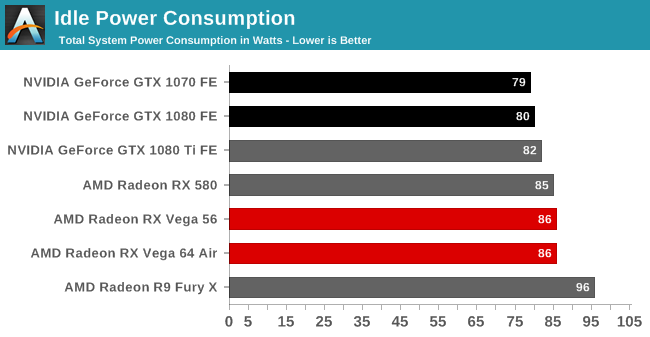
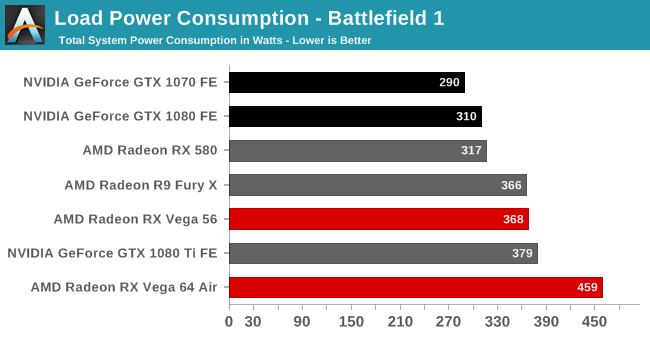
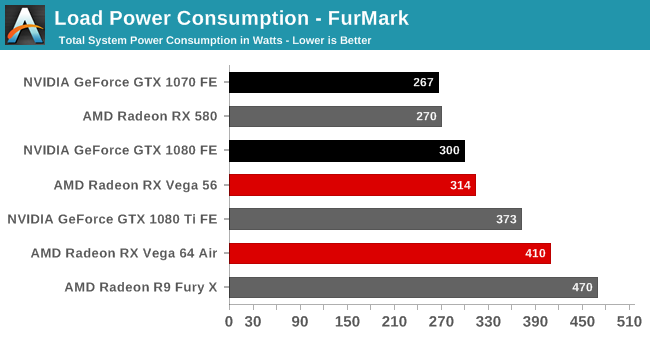
The performance of both Vega cards comes at a significant power cost. For the RX 500 series, we mused that load consumption is where AMD paid the piper. Here, the piper has taken AMD to the cleaners. In Battlefield 1, Vega 64 consumes 150W more system-wide power than the GTX 1080, its direct competitor. To be clear, additional power draw is expected, since Vega 64 is larger in both shader count (4096 vs. 2560) and die size (486mm2 vs. 314mm2) to the GTX 1080. But in that sense, when compared with the 1080 Ti, powered by the 471mm2 GP102, Vega 64 still consumes more power.
As for Vega 64's cut-down sibling, Vega 56's lower temperature target, lower clocks, and lower board power make its consumption look much more reasonable, although it is still well above the 1070.
In any case, the cooling solutions are able to do the job without severe effects on temperature and noise. As far as blowers go, RX Vega 64 and 56 are comparable to the 1080 Ti FE blower.
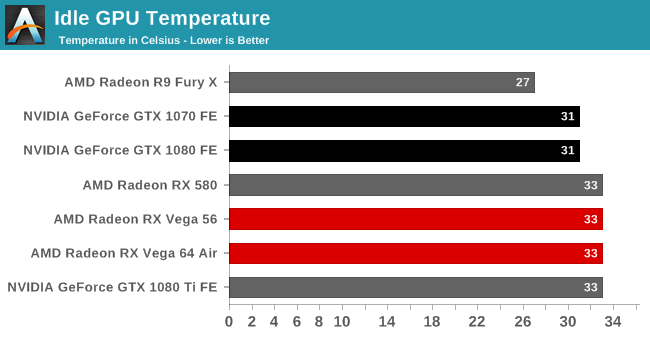
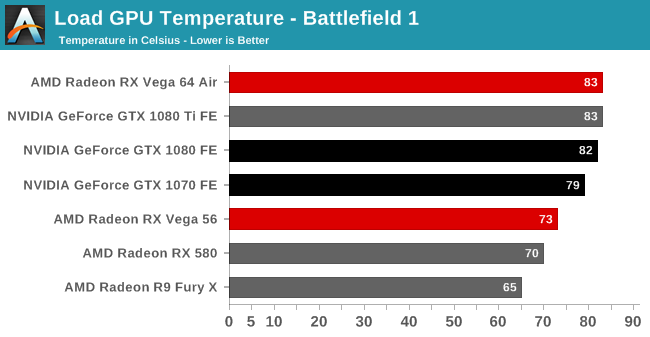

Not Graphed: Temperature of the actual Vega (Star): 9329C
Noise-testing equipment and methodology differ from past results, with a more sensitive noise meter and closer distance to the graphics card. Readings were also taken with an open case. As such, the noise levels may appear higher than expected.

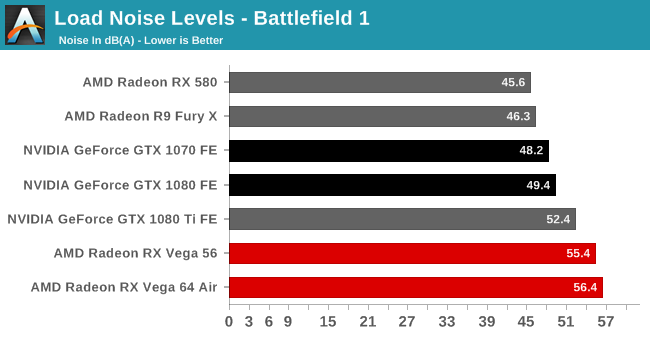
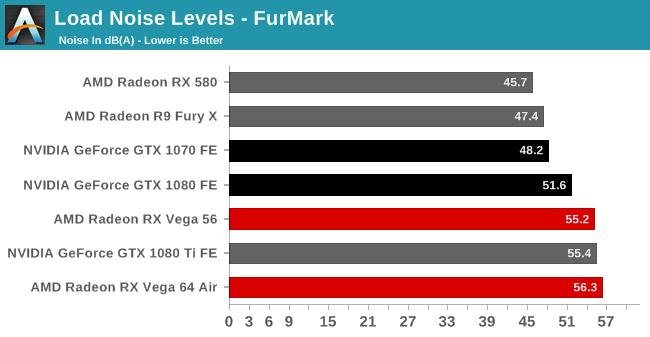










213 Comments
View All Comments
HollyDOL - Tuesday, August 15, 2017 - link
Thank you, I already did. Not everywhere is cheap electricity.Gigaplex - Tuesday, August 15, 2017 - link
A little over $30 per year extra. I tend to upgrade on a 3 year cadence. That's around $100 extra I can use to bump up to the Nvidia card.Outlander_04 - Tuesday, August 15, 2017 - link
The highest cost for electricity I can see in the US is 26 cents per kilowatt hour.The difference in gaming power consumption is 0.078 Kilowatts hour Meaning it would take 12.8 hours to burn that extra kW/H
Two hours of full load gaming every day adds up to 730 hours a year means 57 kW/H's extra for a total cost of $14.82 per year .
In states with electricity cost of 10 cents kW/H the difference is about $5.70 a year
You might have to save a bit longer than you expect .
Yojimbo - Wednesday, August 16, 2017 - link
Why did you assume he was interested in the 1070/Vega 56? Comparing the 1080 FE with the Vega 64 air cooled, the difference is .150 kilowatts. At your same assumption of 2 hours a day and 26 cents a kilowatt-hour it comes to $28.50 a year, right in line with his estimate. It's not a stretch to think he would game more than 730 hours a year, either.Outlander_04 - Thursday, August 17, 2017 - link
The BF1 power consumption difference between Vega 64 and the 1080 FE is 0.08 kW/H.Not sure where you get your numbers from , but it is not this review .
The numbers are essentially the same as I suggested above . 0.078 vs 0.080 .
Less than $6 a year in states with lower utility costs and as much as $15 a year in Hawaii .
Yes you could game more than 14 hours a week . Its also not a stretch to think you might game a lot less . What was your point?
HollyDOL - Friday, August 18, 2017 - link
I don't know where you look, but 1080 FE system is taking 310W, Vega 64 then 459W, which is 149W for no gain whatsoever.Outlander_04 - Friday, August 18, 2017 - link
379 vs 459 watts for the 1080 fe vs Vega 64.delta is 0.08 kW/H
Those figures are right here in this review on the gaming power consumption chart.
HollyDOL - Saturday, August 19, 2017 - link
Lol man, you need to reread that chart. 379W is 1080Ti FE, not 1080FE.FourEyedGeek - Tuesday, August 22, 2017 - link
What if you live in a hot part of the world? Extra heat equals extra throttling, during the summer I reduce my OCs due to this. Slap on the air conditioning and it'll run a bit extra too to compensate costing more.I'd look at undervolting if possible a VEGA 56
ET - Tuesday, August 15, 2017 - link
So Vega 72 yet to come? Page 2 says that there are 6 CU arrays of 3 CU's each. That's 18 CU's, with only 16 enabled in Vegz 64.